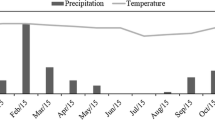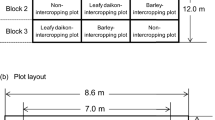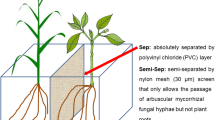Abstract
The effectiveness of maize (Zea mays L.) planted at different times in a maize-cucumber intercrop to reduce the density of cucumber insect pests was investigated in 2007 and 2008. The cucumber varieties Marketmore and Hybrid F1 were established from seed as a monocrop or intercropped with maize, and with maize established 2 weeks before cucumber (2WBC), the same day with cucumber (SDC) or 2 weeks after cucumber (2WAC). Irrespective of the cucumber variety, there was a significant reduction (over 50%) in the density of insect pests in the cucumber-maize intercrop compared with cucumber alone. Similarly, in both years, fruit damage was significantly lower (about 50%) in the intercropped cucumber, particularly at 2WBC and SDC, compared with cucumber alone. Cucumber fruit yield was significantly higher at SDC but significantly lower at 2WBC relative to the other times. In both years, a relatively higher yield for cucumber was obtained at SDC than at 2WBC and 2WAC. Therefore, a significant control of cucumber insect pests and a higher cucumber yield were obtained when cucumber and maize were planted on the same day.
Similar content being viewed by others
References
Alalade C. O. (2005) Effect of lambda-cyhalothrin sprayed at different growth stages on insect pests of cucumber (Cucumis sativus L.) in Abeokuta, southwestern Nigeria. Bachelor of Agriculture Dissertation. Federal University of Agriculture, Abeokuta, Nigeria. 35 pp.
Altieri M. A. (1991) Increasing biodiversity to improve insect pest management in agro-ecosystems, pp. 165–182. In The Biodiversity of Microorganisms and Invertebrates: Its Role in Sustainable Agriculture (edited by D. L. Hawksworth). CAB International, Wallingford, UK.
Altieri M. A., Glaser D. L. and Schmidt L. L. (1990) Diversification of agroecosystems for insect pest regulation: experiments with collards, pp. 70–82. In Agroecology: Researching the Ecological Basis for Sustainable Agriculture. Vol. 78: Ecological Studies (edited by S. R. Gliessman). Springer-Verlag, New York.
Anonymous (2009) Intercropping. Online Information Service for Non-chemical Pest Management in the Tropics. PAN, Germany. Available at: http://www.oisat.org/control_methods/cultural__practices/trap_cropping.html.
Asiwe J. A. N., Nokoe S., Jackai L. E. N. and Ewete F. K. (2005) Does varying cowpea spacing provide better protection against cowpea pests? Crop Protection 24, 465–471.
Beaulieu J. C. and Grimm C. C. (2001) Identification of volatile compounds in cantaloupe at various developmental stages using solid phase microextraction. Journal of Agricultural and Food Chemistry 49, 1345–1352.
Daly H. V. (1985) Insect morphometrics. Annual Review of Entomology 30, 415–438.
Do J. Y., Salunkhe D. K. and Olson L. E. (2006) Isolation, identification and comparison of the volatiles of peach fruit as related to harvest maturity and artificial ripening. Journal of Food Science 34, 618–621.
Echezona B. C. and Mbah M. C. (2001) Okra growth, development and Podagrica attack in relation to weed presence and carbofuran application, pp. 135–141. In Book of Proceedings of the 19th Annual Conference of the Horticultural Society of Nigeria (HORTSON) (edited by B. N. Mbah and K. P. Baiyeri). Horticultural Society of Nigeria, Ibadan, Nigeria.
Ezueh M. I. and Taylor A. T. (1983) Effects of time of intercropping with maize on cowpea susceptibility to three major pests. Tropical Agriculture (Trinidad) 61, 82–86.
Hummel R. L., Walgenbach J. F., Hoyt G. D. and Kennedy G. G. (2002) Effects of production system on vegetable arthropods and their natural enemies. Agriculture, Ecosystems & Environment 93, 165–176.
Iragavarapu T. K. and Randall G. W. (1996) Border effects on yields in a strip-intercropped soybean, corn, and wheat production system. Journal of Production Agriculture 9, 101–107.
Jinadu G. M., (2005) Trials on organochlorine and pyrethroid insecticides for the control of fruit flies of cucumber in Abeokuta southwestern Nigeria. Bachelor of Agriculture Dissertation. Federal University of Agriculture, Abeokuta, Nigeria. 35 pp.
John S. A., Mini C., Joseph S. and Savithri K. E. (2004) Performance of different intercrops in okra based cropping system. South Indian Horticulture 52, 175–182.
Karel A. K., Ladhani D. A. and Ndunguru B. J. (1982) Intercropping of maize and cowpea: effect of plant populations on insect pests and seed yield. In Intercropping: Proceedings of the Second Symposium on Intercropping in Semi-Arid Areas 4–7 August 1980, Morogoro, Tanzania (edited by C. L. Keswani and B. J. Ndunguru). IDRC, Ottawa; pp. 102–109.
Kawuki R. S., Agona A., Nampala P. and Adipala E. (2005) A comparison of effectiveness of plant-based and synthetic insecticides in the field management of pod and storage pests of cowpea. Crop Protection 24, 473–478.
Koona P., Osisanya E. O., Jackai L. E. N., Tamo M. and Markham R. H. (2002) Resistance in accessions of cowpea to the coreid pod-bug Clavigralla tomentosicollis (Hemiptera: Coreidae). Journal of Economic Entomology 95, 1281–1288.
Matteson P. C. (1982) The effects of intercropping with cereals and minimal permethrin applications on insect pests of cowpea and their natural enemies in Nigeria. Tropical Pest Management 28, 372–380.
McKinlay R. G. (1992) Vegetable Crop Pests. CRC Press, Boca Raton, FL. 406 pp.
Mohamed M. F., Dokashi M. H., Mousa M. A. A. and Elnobi E.-E. F. E. (2007) Yield of crops in within-row intercropped okra-cowpea or okra-cucumber. International Journal of Vegetable Science 13, 33–48.
Mousa M. A. A., Mohammed M. F., Dokashi M. H. and Elnobi E.-E. F. E. (2007) Intra-row intercropping of cowpea and cucumber with okra as influenced by planting date of secondary crops. Assuit University Bulletin of Environmental Research 10, 13–33.
Ofosu-Anim J. and Limbani N. V. (2007) Effect of intercropping on the growth and yield of cucumber (Cucumis sativus L.) and okra (Abelmoschus esculentus L. Moench). International Journal of Agriculture and Biology 4, 594–597.
Ofuya T. I. (1991) Observations on insect infestation and damage in cowpea (Vigna unguiculata) intercropped with tomato (Lycopersicon esculentum) in a rain forest area of Nigeria. Experimental Agriculture 27, 407–412.
Ogenga-Latigo M. W., Baliddawa C. W. and Ampofo J. K. O. (1992) Influence of maize row spacing on infestation and damage of intercropped beans by the bean aphid (Aphis fabae Scop.). II. Reduction in bean yields. Field Crops Research 30, 123–130.
Organic Garden Information Communication (2007) Organic gardening intercropping. Organic Garden Extension Service. http://www.organicgardeninfo.com/ intercropping.html.
Papadopoulos N. T., Kouloussis N. A. and Katsoyannos B. I. (2008) Effect of plant chemicals on the behaviour of the Mediterranean fruit fly, pp. 97–106. In Fruit Flies of Economic Importance: From Basic to Applied Knowledge (edited by R. L. Sugayam, R. A. Zucchi, S. M. Ovruski and J. Sivinski). SBPC, Salvador.
Perfect T. J. A., Cook A. G. and Critchley B. R. (1979) Effects of intercropping maize and cowpea on pest incidence in Ibadan. In Internal Report 1976-1978. International Institute of Tropical Agriculture (IITA), Ibadan, Nigeria.
Pitan O. O. R. and Odebiyi J. A. (2001) The effect of intercropping with maize on the level of infestation and damage by pod-sucking bugs in cowpea. Crop Protection 20, 367–372.
Pitan O. O. R. and Odebiyi J. A. (2002) Effect of intra-row spacing of cowpea on pod-sucking bug population and damage in Ibadan, Nigeria. Nigerian Journal of Entomology 19, 31–39.
Pitan O. O. R., Odebiyi J. A., Adeoye G. O. and Osisanya E. O. (2002) Influence of maize intercropping and minimal insecticide usage on the pod-sucking bugs of cowpea. Tropical Agriculture (Trinidad) 78, 48–51.
Pitan O. O. R. and Olatunde G. O. (2006) Effects of intercropping tomato (Lycopersicon esculentum) at different times with cowpea (Vigna unguiculata) or okra (Abelmoschus esculentus) on crop damage by major insect pests. Journal of Agricultural Science 144, 361–368.
Rärt B., Lennartsson M. and Davies G. (2002) The use of mixed species cropping to manage pests and diseases — theory and practice, pp. 207–210. In Proceedings of the UK Organic Research 2002 Conference (edited by J. Powell et al.). Organic Centre Wales, Institute of Rural Studies. University of Wales, Aberystwyth.
Randall P. G. (2004) HGIC 2207, Cucumber, Squash, Melon & other Cucurbit Insect Pests. Clemson University Cooperative Extension Service, SC, USA. 5 pp. Available at: http://www.clemson.edu/ extension/hgic/pests/plant_pests/veg_fruit/hgic2207.html.
Schipper R. R. (2000) African Indigenous Vegetables: An Overview of the Cultivated Species. Natural Resource Institute. EU Technical Centre of Agriculture and Rural Cooperation, Chatham, UK. 214 pp.
Tahvanainen J. O. and Root R. B. (1972) The influence of vegetational diversity on the population ecology of a specialized herbivore, Phyllotreta cruciferae (Coleoptera Chrysomelidae). Oecologia 10, 321–346.
Taylor F. and Schrader R. (1984) Transient effects of photoperiod on reproduction in the Mexican bean beetle. Physiological Entomology 9, 459–464.
Trenbath B. R. (1993) Intercropping for the management of pests and diseases. Field Crop Research 34, 381–405.
Valenzuela H. R., Hamasaki R. T. and Fukuda S. K. (1994) Field Cucumber Production Guidelines for Hawai’i. Research Extension Series 151-10/94. Hawaii Institute of Tropical Agriculture and Human Resources, Honolulu, Hawai’i. 19 pp.
Wright M. G. and Hoffman M. P. (2001) Selection of Vegetables for Intercropping as a Pest Management Strategy. Department of Entomology, Cornell University, Ithaca, NY, January 2001. Available at: http://www.organic.cornell.edu/ research/tsfsumms/organicpdfs/7intercrop.pdf.
Author information
Authors and Affiliations
Corresponding author
Rights and permissions
About this article
Cite this article
Pitan, O.O.R., Filani, C.O. Effect of intercropping cucumber Cucumis sativus (Cucurbitaceae) at different times with maize Zea mays (Poaceae) on the density of cucumber insect pests. Int J Trop Insect Sci 34, 269–276 (2014). https://doi.org/10.1017/S1742758414000435
Accepted:
Published:
Issue Date:
DOI: https://doi.org/10.1017/S1742758414000435




